2012 RENAULT CLIO SPORT TOURER steering wheel
[x] Cancel search: steering wheelPage 97 of 264

engine start/stop button ........................ (up to the end of the DU)
ignition switch ....................................... (up to the end of the DU)
starting the engine ................................ (up to the end of the DU)
starting the engine ................................ (up to the end of the DU)
switching on the vehicle ignition ........... (up to the end of the DU)
2.3
ENG_UD26548_3
Contacteur de démarrage : véhicule avec clé / télécommand\
e à radiofréquence (X85 - B85 - C85 - S85 - K85 - Renault)
ENG_NU_853-8_BCSK85_Renault_2
Ignition switch
Special note on vehicles with an au-
tomatic gearbox
Before starting, move the lever to posi-
tion N or P.
Note:
If a gear other than neutral is displayed,
it flashes; starting is not possible unless
you depress the brake pedal, while
holding the key in the starting position.Ignition position M.
The ignition is switched on:
Start position D
If the engine fails to start at the first
attempt, the key must be turned back
before the starter can be activated
again. Release the key as soon as the
engine starts.
Note: on diesel versions, several sec -
onds may pass between turning the
key and the engine starting to allow for
engine preheating.
Off position S (steering lock
applied)
To lock: remove the key and turn the
steering wheel until the steering column
locks.
To unlock: turn the key and the steering
wheel slightly.
“Accessories” position A
When the ignition is switched off, any
accessories (radio, etc.) will continue to
function.
IGNITION SWITCH: vehicle with key
Page 100 of 264
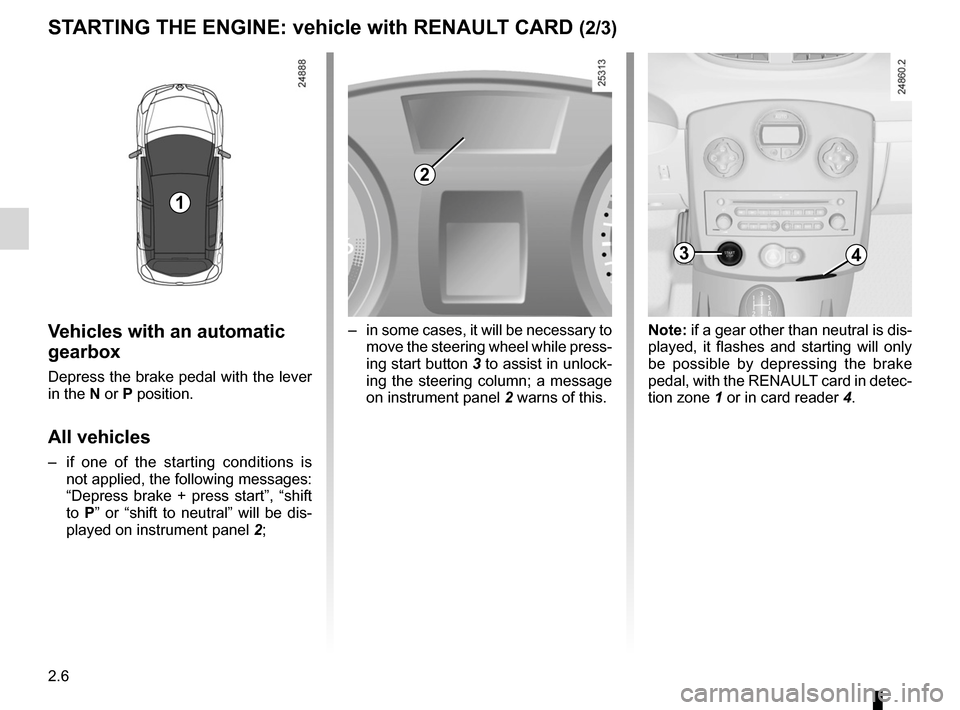
2.6
ENG_UD26550_2
Démarrage moteur : véhicule avec carte Renault (X85 - B85 - C85 -\
S85 - K85 - Renault)
ENG_NU_853-8_BCSK85_Renault_2
Jaune NoirNoir texte
Note: if a gear other than neutral is dis-
played, it flashes and starting will only
be possible by depressing the brake
pedal, with the RENAULT card in detec-
tion zone 1 or in card reader 4.
–
in some cases, it will be necessary to
move the steering wheel while press-
ing start button 3 to assist in unlock-
ing the steering column; a message
on instrument panel 2 warns of this.Vehicles with an automatic
gearbox
Depress the brake pedal with the lever
in the N or P position.
All vehicles
– if one of the starting conditions is
not applied, the following messages:
“Depress brake + press start”, “shift
to P” or “shift to neutral” will be dis-
played on instrument panel 2;
STARTING THE ENGINE: vehicle with RENAULT CARD (2/3)
2
34
34
1
Page 113 of 264

driving ................................................... (up to the end of the DU)
Electronic Stability Program: ESP ........ (up to the end of the DU)
ESP: Electronic Stability Program ........ (up to the end of the DU)
2.19
ENG_UD10562_1
Contrôle dynamique de conduite : E.S.P. avec contrôle de sous-virage (X85 - B85 - C85 - S85 - K85 - Renaul\
t)
ENG_NU_853-8_BCSK85_Renault_2
This system helps to keep control of
the vehicle in critical driving situations
(avoiding an obstacle, loss of grip when
cornering, etc.) and works in conjunc -
tion with the ‘understeer control’
system .
Electronic Stability Program: ESP
This function is an addi -
tional aid in the event of
critical driving conditions,
enabling the vehicle behav -
iour to be adapted to suit the driving
conditions.
However, the function does not take
the place of the driver. It does not
increase the vehicle’s limits and
should not encourage you to
drive more quickly.
Therefore, it can under no circum -
stances replace the vigilance or re-
sponsibility of the driver when ma -
noeuvring the vehicle (the driver
must always be ready for sudden in-
cidents which may occur when driv-
ing).
When the E.S.P. function starts operat-
ing, warning light A flashes to warn you.
If the warning light comes on accompa -
nied by the ‘traction control deselected’
message when the engine is started,
slowly turn the steering wheel from lock
to lock to reinitialise the system.
Understeer control
This system optimises the action of
the E.S.P. in the case of pronounced
understeering (loss of front axle road
holding).
Operating principle
A sensor in the steering wheel detects
the direction selected by the driver.
Other sensors throughout the vehicle
measure the actual direction.
The system compares the direction se-
lected by the driver and the actual di -
rection of the vehicle and corrects this
as necessary by applying the brakes
selectively and/or acting on the engine
power.
ELECTRONIC STABILITY PROGRAM: E.S.P. (1/2)
A
Page 115 of 264

traction control: ASR .............................(up to the end of the DU)
driving ................................................... (up to the end of the DU)
traction control: ASR .............................(up to the end of the DU)
2.21
ENG_UD10563_1
Système antipatinage : A.S.R. (X85 - B85 - C85 - S85 - K85 - Renault)
ENG_NU_853-8_BCSK85_Renault_2
Traction control: ASR
This function is an addi -
tional aid in the event of
critical driving conditions,
enabling the vehicle behav -
iour to be adapted to suit the driving
conditions.
However, the function does not take
the place of the driver. It does not
increase the vehicle’s limits and
should not encourage you to
drive more quickly.
Therefore, it can under no circum -
stances replace the vigilance or re-
sponsibility of the driver when ma -
noeuvring the vehicle (the driver
must always be ready for sudden in-
cidents which may occur when driv-
ing).
The system also adjusts the engine
speed to the grip available under the
wheels, independently of the pressure
exerted on the accelerator pedal.
When the function begins to operate,
warning light A flashes to warn you.
If the warning light comes on accompa -
nied by the ‘traction control deselected’
message when the engine is started,
slowly turn the steering wheel from lock
to lock to reinitialise the system.
Operating principle
Using the wheel sensors, the system
measures and compares the speed of
the drive wheels at all times and slows
down their over-rotation.
If a wheel is starting to slip, the system
brakes automatically until the drive sup-
plied becomes compatible with the level
of grip under the wheel again.
This system helps to limit skidding on
drive wheels and to control the vehicle
when pulling away or accelerating.
TRACTION CONTROL: A.S.R. (1/2)
A
Page 172 of 264
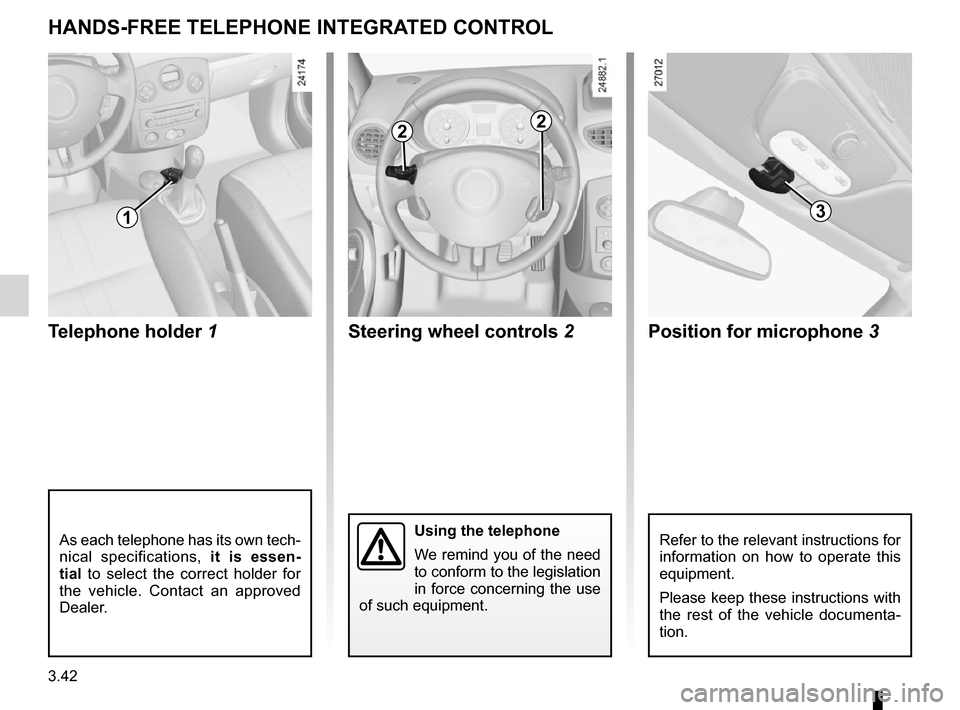
hands-free telephone integrated control
(up to the end of the DU)
3.42
ENG_UD10587_1
Commande intégrée de téléphone mains libres (X85 - B85 - C8\
5 - S85 - K85 - Renault)
ENG_NU_853-8_BCSK85_Renault_3
t elephone holder 1 Position for microphone 3
steering wheel controls 2
Hands-free telephone integrated control
Refer to the relevant instructions for
information on how to operate this
equipment.
Please keep these instructions with
the rest of the vehicle documenta -
tion.Using the telephone
We remind you of the need
to conform to the legislation
in force concerning the use
of such equipment.As each telephone has its own tech-
nical specifications, it is essen-
tial to select the correct holder for
the vehicle. Contact an approved
Dealer.
HanDs-Free teLePHOne inteGrateD COntrOL
1
22
3
Page 202 of 264
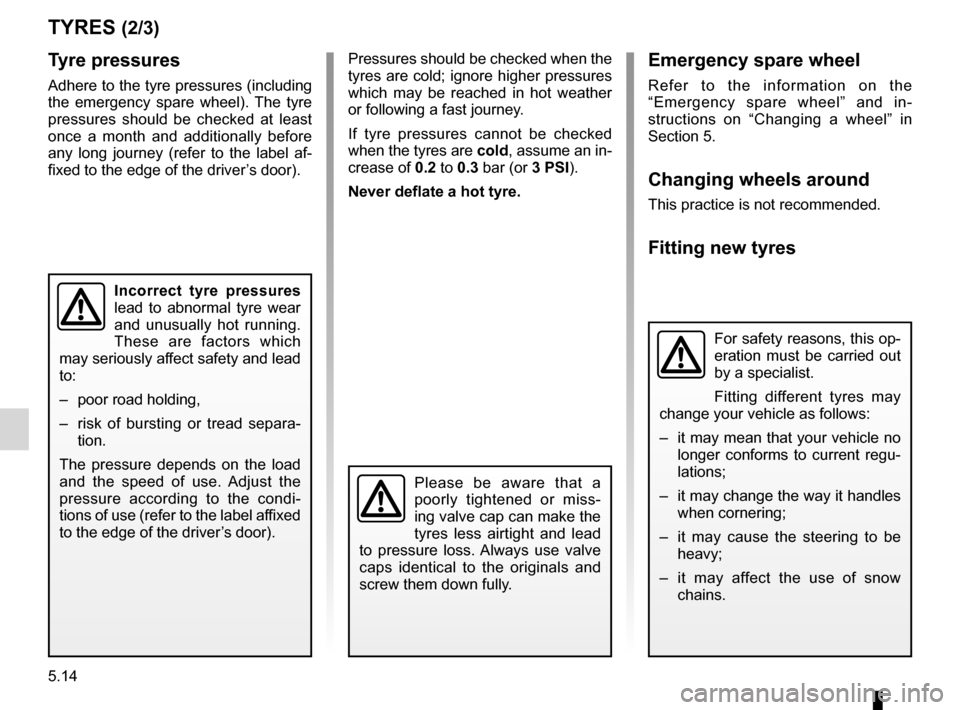
tyre pressure.......................................................... (current page)
5.14
ENG_UD22328_2
Pneumatiques (X85 - B85 - C85 - S85 - K85 - Renault)
ENG_NU_853-8_BCSK85_Renault_5
Jaune NoirNoir texte
Emergency spare wheel
Refer to the information on the
“Emergency spare wheel” and in -
structions on “Changing a wheel” in
Section 5.
Changing wheels around
This practice is not recommended.
Fitting new tyres
For safety reasons, this op-
eration must be carried out
by a specialist.
Fitting different tyres may
change your vehicle as follows:
– it may mean that your vehicle no
longer conforms to current regu-
lations;
– it may change the way it handles
when cornering;
– it may cause the steering to be
heavy;
– it may affect the use of snow
chains.
Pressures should be checked when the
tyres are cold; ignore higher pressures
which may be reached in hot weather
or following a fast journey.
If tyre pressures cannot be checked
when the tyres are cold, assume an in-
crease of 0.2 to 0.3 bar (or 3 PSI).
Never deflate a hot tyre.
TYRES (2/3)
Please be aware that a
poorly tightened or miss -
ing valve cap can make the
tyres less airtight and lead
to pressure loss. Always use valve
caps identical to the originals and
screw them down fully.
Incorrect tyre pressures
lead to abnormal tyre wear
and unusually hot running.
These are factors which
may seriously affect safety and lead
to:
– poor road holding,
– risk of bursting or tread separa -
tion.
The pressure depends on the load
and the speed of use. Adjust the
pressure according to the condi -
tions of use (refer to the label affixed
to the edge of the driver’s door).
Tyre pressures
Adhere to the tyre pressures (including
the emergency spare wheel). The tyre
pressures should be checked at least
once a month and additionally before
any long journey (refer to the label af -
fixed to the edge of the driver’s door).
Page 214 of 264
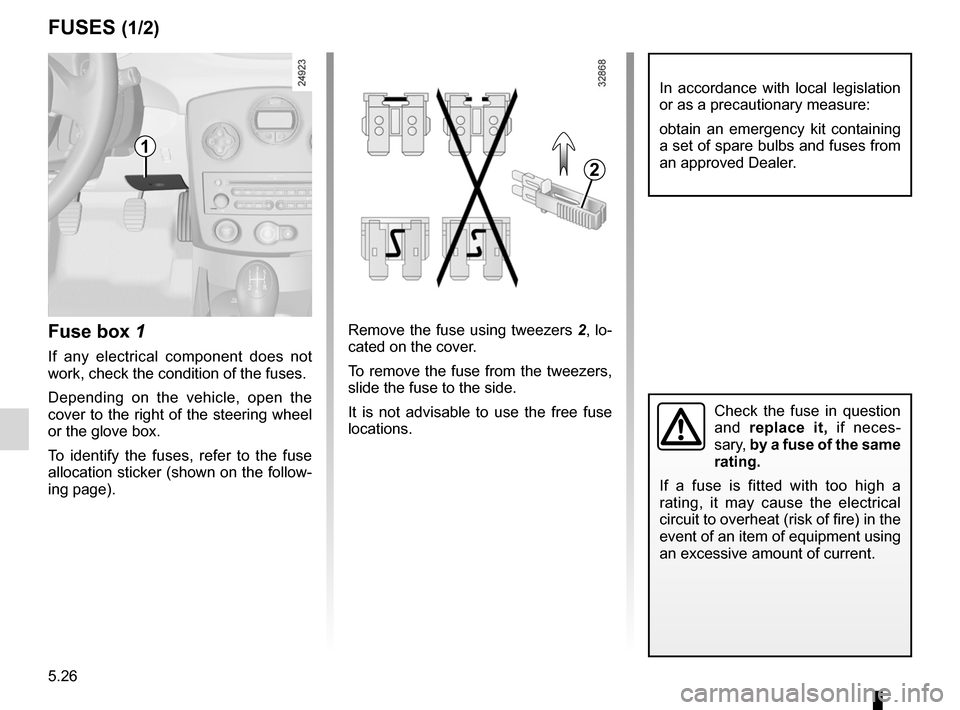
fuses ..................................................... (up to the end of the DU)
5.26
ENG_UD24921_5
Fusibles (X85 - B85 - C85 - S85 - K85 - Renault)
ENG_NU_853-8_BCSK85_Renault_5
Jaune NoirNoir texte
Remove the fuse using tweezers 2, lo-
cated on the cover.
To remove the fuse from the tweezers,
slide the fuse to the side.
It is not advisable to use the free fuse
locations.
Fuses
Check the fuse in question
and replace it, if neces-
sary, by a fuse of the same
rating.
If a fuse is fitted with too high a
rating, it may cause the electrical
circuit to overheat (risk of fire) in the
event of an item of equipment using
an excessive amount of current.
Fuse box 1
If any electrical component does not
work, check the condition of the fuses.
Depending on the vehicle, open the
cover to the right of the steering wheel
or the glove box.
To identify the fuses, refer to the fuse
allocation sticker (shown on the follow -
ing page).
FUSES (1/2)
1
In accordance with local legislation
or as a precautionary measure:
obtain an emergency kit containing
a set of spare bulbs and fuses from
an approved Dealer.
2
Page 218 of 264
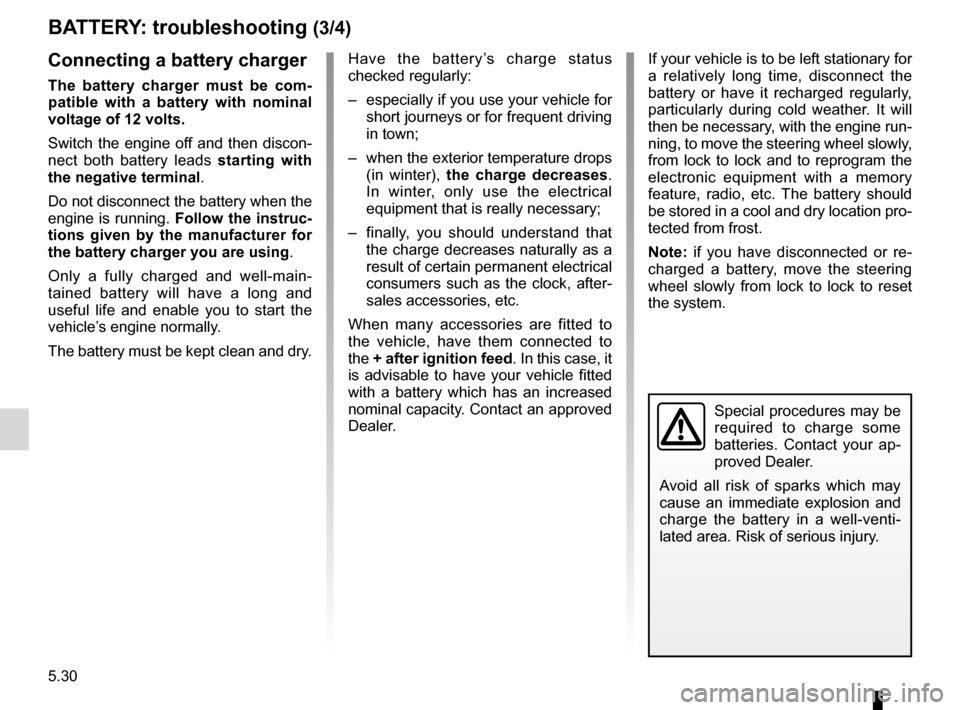
5.30
ENG_UD12592_2
Batterie : dépannage (X85 - B85 - C85 - S85 - K85 - Renault)
ENG_NU_853-8_BCSK85_Renault_5
Jaune NoirNoir texte
BATTERY: troubleshooting (3/4)
Special procedures may be
required to charge some
batteries. Contact your ap-
proved Dealer.
Avoid all risk of sparks which may
cause an immediate explosion and
charge the battery in a well-venti -
lated area. Risk of serious injury.
If your vehicle is to be left stationary for
a relatively long time, disconnect the
battery or have it recharged regularly,
particularly during cold weather. It will
then be necessary, with the engine run-
ning, to move the steering wheel slowly,
from lock to lock and to reprogram the
electronic equipment with a memory
feature, radio, etc. The battery should
be stored in a cool and dry location pro-
tected from frost.
Note: if you have disconnected or re -
charged a battery, move the steering
wheel slowly from lock to lock to reset
the system.
Have the battery’s charge status
checked regularly:
–
especially if you use your vehicle for
short journeys or for frequent driving
in town;
– when the exterior temperature drops
(in winter), the charge decreases .
In winter, only use the electrical
equipment that is really necessary;
– finally, you should understand that
the charge decreases naturally as a
result of certain permanent electrical
consumers such as the clock, after-
sales accessories, etc.
When many accessories are fitted to
the vehicle, have them connected to
the + after ignition feed. In this case, it
is advisable to have your vehicle fitted
with a battery which has an increased
nominal capacity. Contact an approved
Dealer.Connecting a battery charger
The battery charger must be com -
patible with a battery with nominal
voltage of 12 volts.
Switch the engine off and then discon -
nect both battery leads starting with
the negative terminal.
Do not disconnect the battery when the
engine is running. Follow the instruc-
tions given by the manufacturer for
the battery charger you are using.
Only a fully charged and well-main -
tained battery will have a long and
useful life and enable you to start the
vehicle’s engine normally.
The battery must be kept clean and dry.